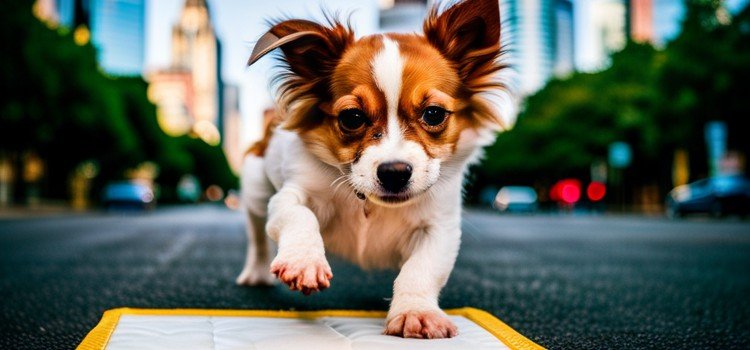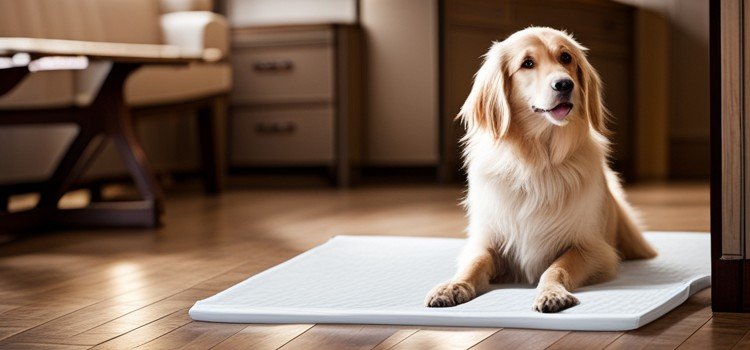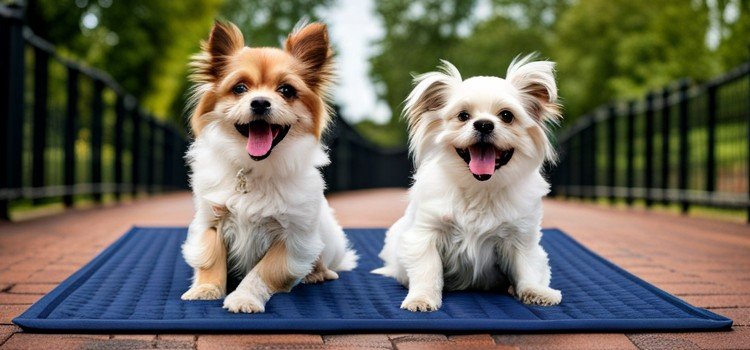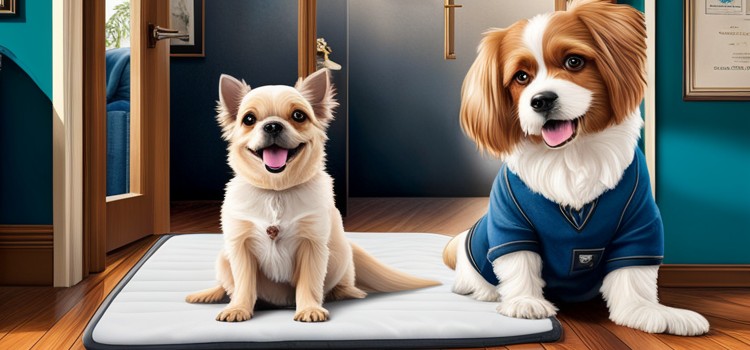As an Amazon Associate committed to the mission of improving the lives of our readers, Live-Clear.com receives a small commission from eligible purchases made through our affiliate links. This revenue enables us to keep producing insightful articles and other material.
Many dog owners have faced a common and frustrating issue – their beloved canine companions peeing right next to the designated pad or area. This perplexing behaviour can leave pet parents scratching their heads. This article will explore the reasons behind this behaviour, helping you understand why your dog might miss the mark. We’ll explore various factors, from training issues to medical concerns, and provide practical solutions to address this problem.

The Importance of Proper Training
Lack of Training Consistency
One of the primary reasons your dog may not be using the pad correctly is inconsistent training. Dogs thrive on routine; they can understand if the activity is consistent. Consistency in training helps dogs establish a clear understanding of what is expected from them. With consistent training, dogs may become apparent and able to grasp the concept of using the pad correctly. Additionally, inconsistent training can lead to mixed signals, making it difficult for dogs to learn and develop good habits.
Insufficient Positive Reinforcement
Positive reinforcement is vital to successful pad training. If your dog needs more praise and rewards for using the pad correctly, they may lose motivation. This can result in a lack of progress and a higher likelihood of accidents. Additionally, without sufficient positive reinforcement, dogs may not associate using the pad with a positive experience, making it harder for them to use it in the future.
Using Punishment
Punishing your dog for accidents can backfire. It can create anxiety and fear, making them reluctant to use the pad. This can lead to a decrease in their overall confidence and trust in their owner, making it even more challenging to train them to use the pad correctly. Additionally, punishment can also cause physical and emotional harm to the dog, damaging the bond between them and their owner.
Read More About: Teaching an Older Dog to Use Pee Pads
Medical Factors
Urinary Tract Infections
Medical issues can be a culprit. Dogs with urinary tract infections may have difficulty controlling their bladder, leading to accidents near the pad. It is essential to consult a veterinarian if a dog consistently has accidents near the pad, as they can provide proper diagnosis and treatment for any underlying medical conditions. Additionally, certain medications or treatments for other health issues may also affect a dog’s ability to control their bladder, further complicating their training process.
Incontinence
Incontinence, especially in older dogs, can cause involuntary urination. This can result in peeing near the pad rather than on it. Weakened bladder muscles or hormonal imbalances can cause incontinence, and it is essential to address this issue with a veterinarian to explore potential treatment options. Additionally, providing extra support and comfort for older dogs, such as using absorbent pads or diapers, can help manage incontinence and prevent accidents outside the designated area.
Environmental Stressors
Changes in the Household
Dogs are sensitive to changes in their environment. Moving to a new house or experiencing disruptions can affect their bathroom habits. It is essential to provide a stable and predictable environment for dogs to help alleviate any stress or anxiety contributing to changes in their bathroom habits. Additionally, gradually introducing them to new changes or disruptions can help them adjust more efficiently and minimize the impact on their bathroom routine.
Marking Behavior
Some dogs mark their territory by urinating in specific spots. This can happen even if they’re pad-trained. Marking behavior is an instinct for dogs, especially males, to establish their presence and communicate with other dogs. It is essential to differentiate between marking behavior and inappropriate urination, as marking is not necessarily a sign of a bathroom habit problem. However, if marking becomes excessive or occurs indoors, it may be necessary to address the behavior through training and management techniques.
Pad Placement and Cleanliness
Pad Location
The location of the pad can influence your dog’s success. It should be easily accessible and in a quiet, low-traffic area. This will help your dog feel comfortable and reduce distractions that may interfere with their ability to use the pad consistently. Additionally, placing the pad in a consistent location will help reinforce the habit and make it easier for your dog to understand where they should go to relieve themselves.
Dirty Pads
Dirty pads are unappealing to dogs. If you don’t change them regularly, your dog might avoid using them. Regularly changing the pads will ensure cleanliness and encourage your dog to continue using them. Additionally, cleaning up any accidents or messes promptly will help maintain a hygienic environment for your dog and prevent any lingering odors that may discourage them from using the pad.
Read More About: How to Get Dog Pee Out of Carpet Pad
Behavioral Issues
Anxiety and Stress
Anxiety and stress can lead to accidents. Dogs may pee near the pad due to emotional distress. This can happen if they are anxious or stressed, as these emotions can affect their bladder control. It is essential to address the underlying causes of their anxiety or stress and provide them with a calm and comfortable environment to help prevent accidents from occurring.
Dominance and Submissiveness
In multi-dog households, dominance and submission dynamics can affect where dogs urinate. Some dogs may mark their territory by urinating in certain areas to assert dominance over other dogs. On the other hand, submissive dogs may avoid urinating in certain areas to show deference to more dominant dogs. Understanding and managing these dynamics can help create a harmonious environment and prevent inappropriate urination.
Solutions to the Problem
Reinforce Training
Consistent, positive reinforcement-based training is crucial. Reward your dog every time they use the pad correctly. This will help them associate the pad with positive experiences and increase their likelihood of using it. Additionally, consistently redirecting your dog to the designated potty area can help reinforce the desired behavior and discourage inappropriate urination.
Rule Out Medical Issues
Consult your vet to rule out any medical conditions causing the behavior. Medical issues such as urinary tract infections or bladder stones can cause dogs to have accidents in the house. It’s essential to address any underlying health problems before solely focusing on training methods.
Adjust Pad Placement
Experiment with the pad’s location to see if your dog prefers a different spot. Some dogs may prefer a specific area or surface to eliminate. By adjusting the pad’s placement, you can potentially find a spot that better suits your dog’s preferences and encourages them to use it consistently. Additionally, consider providing multiple pads in different areas of the house to increase accessibility and convenience for your dog.
Reduce Stressors
Minimize environmental stressors and create a calm atmosphere at home. This can be done by providing a quiet and comfortable space for your dog. Avoid loud noises or distractions that may startle or distract them from using the pad. Additionally, try to establish a consistent routine for bathroom breaks to help reduce any anxiety or confusion your dog may have.

Conclusion
Understanding why your dog pees next to the pad is the first step in solving this issue. It could result from training inconsistencies, medical problems, environmental stressors, or behavioural factors. By addressing these issues and following our solutions, you can help your furry friend use the pad correctly.
Read More About: Can Dogs Use Pee Pads Forever
FAQs
It’s best to avoid scolding as it can create fear and anxiety. Positive reinforcement is more effective in training.
Change the pad regularly, ideally after each use or whenever it gets soiled.
Consult with a professional dog trainer to assess and address any behavioural issues.
No, punishment can worsen the behaviour. Consult with a dog behaviourist for appropriate solutions.
Yes, stress can exacerbate incontinence issues in some dogs. Reducing stress can help improve the situation.
This article explored why your dog might be peeing next to the training pad and provided solutions to this common problem. Patience, consistency, and positive reinforcement are essential to successful pad training for your furry friend.
Amazon and the Amazon logo are trademarks of Amazon.com, Inc, or its affiliates.



